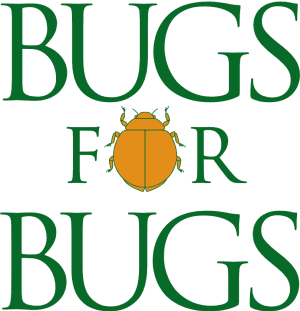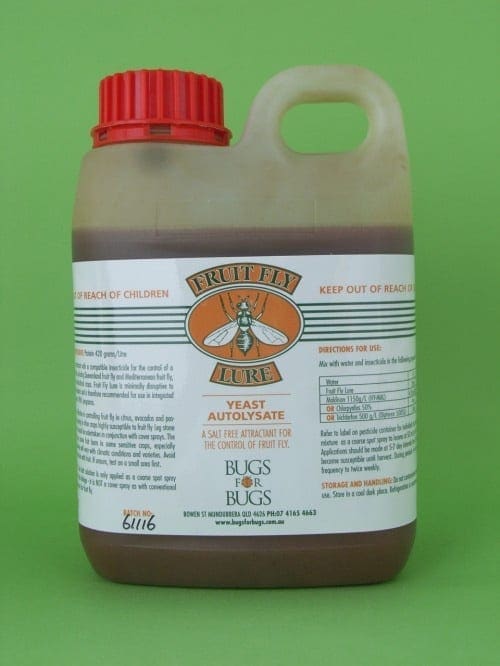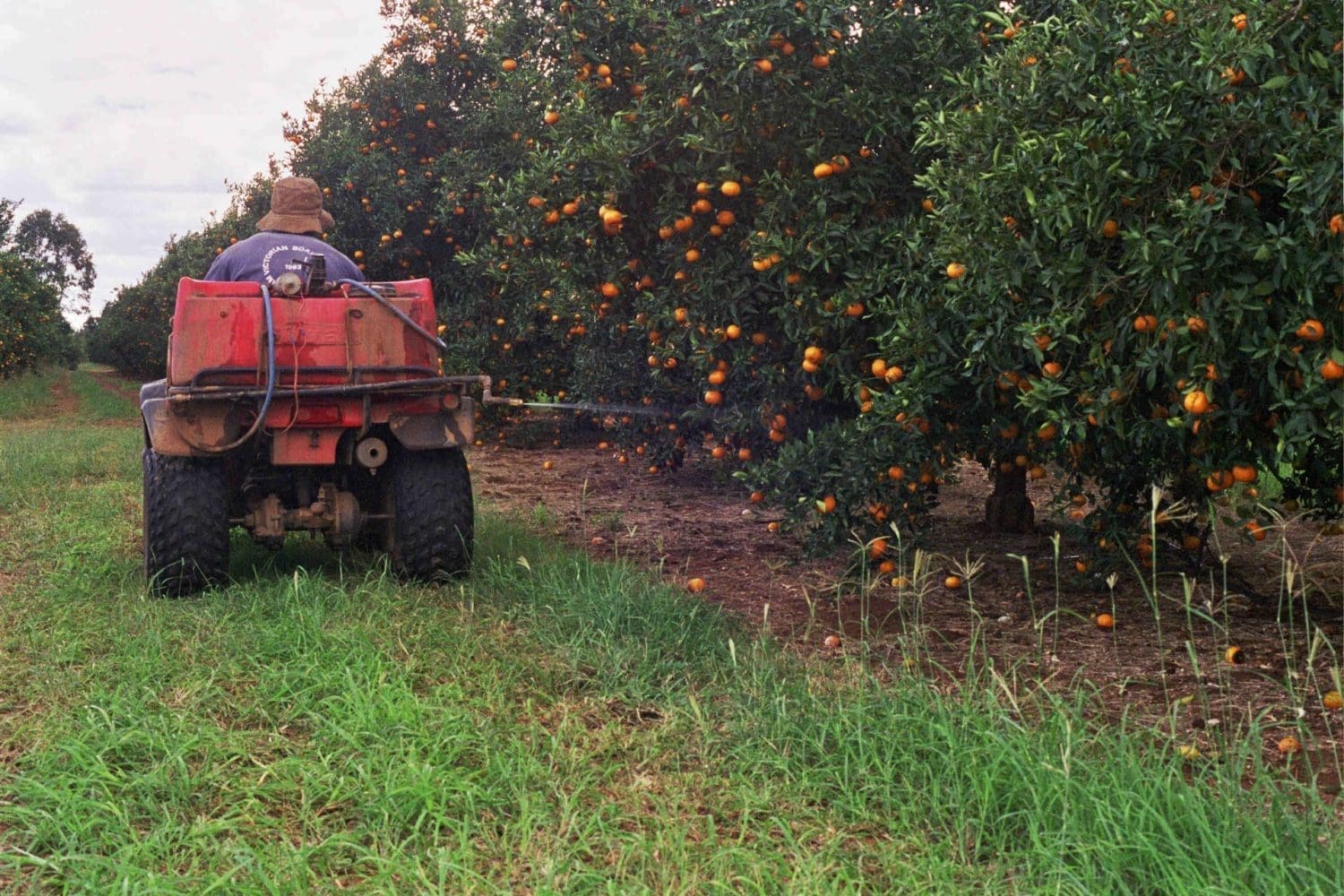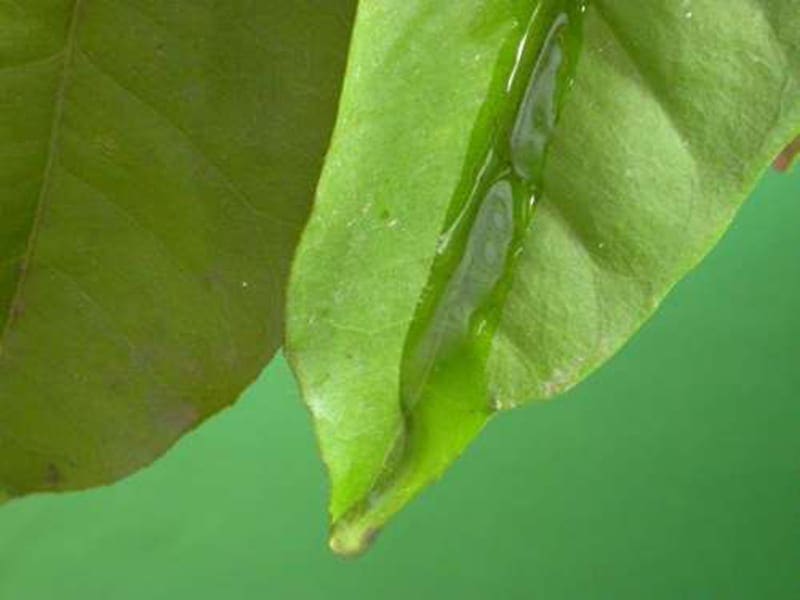Description
Fruit Fly Lure is an autolysed protein highly attractive to Queensland and Mediterranean fruit flies. It needs to be mixed with a toxicant and can then be used to attract and kill adult fruit flies.
About protein bait sprays
How does it work?
- A protein + toxicant attracts and kills female flies
- Female fruit flies must feed on protein before they can sting fruit
How to mix our protein bait
- For best results, use with our Fruit Fly Lure Thickener
- Mix thickener with water 24 hours before use
- Add Bugs for Bugs Fruit Fly Lure at 2 L per 100 L of thickened water
- Add toxicant at the label rate (see table with list of registered products below)
How to apply our protein bait
- Apply fresh on day of mixing
- Use 15 L of mixture per ha
- Apply as a spot or band to the host plants or suitable substrate
- Note: this is not a cover spray
When to apply
- Start early (before fruit becomes susceptible) and continue for at least 3 weeks after harvest
- Apply every 5-7 days (more often if you see any signs of damage or increased fruit fly activity)
- Re-apply after rain
How much Fruit Fly Lure do I need?
Our Fruit Fly lure comes in four pack sizes:
- 1 L (roughly enough to treat 1 ha 3 times)
- 2.5 L (roughly enough to treat 1 ha 7.5 times)
- 5 L (roughly enough to treat 1 ha 14 times)
- 15 L (roughly enough to treat 1 ha 42 times)
Tips for best results
- Start early – at least 2 weeks before fruit becomes susceptible
- Apply regularly
- Don’t miss a treatment
- Increase frequency during high risk periods
- Add Fruit Fly Lure Thickener for best results
- Protein bait should ideally be placed on foliage or trunk of the host plant
- Do not apply protein bait to ground or grass
- Note that protein bait may cause fruit burn – test before use and minimise fruit contact
- Treating larger areas including non-fruiting blocks and surrounds will improve results
Toxicants registered for use with Fruit Fly Lure
This table lists toxicants registered for use with Fruit Fly Lure and other autolysed yeast protein baits for fruit flies in Australia in August 2022. Refer to product labels for all critical use comments.
| Toxicant | Rate per 100 L water | Pests | States | Crops | WHP (days) |
| Abamectin 36 g/L
(e.g. Sorcerer 36) |
12.5 mL | Queensland Fruit Fly | All States | Blackberries
Raspberries Blueberries Citrus |
7 |
| Abamectin 18 g/L
(e.g. Vertimec Pro) |
25 mL | ||||
| Chlorpyrifos 750 g/kg
(e.g. EuroChem Chlorpyrifos 750) |
267 g | Queensland Fruit Fly | NSW & Qld only | Avocado
Citrus Passion Fruit Stone Fruit |
Avocado 7
Other crops 14 |
| Chlorpyrifos 500 g/kg
(e.g. Strike-Out 500 ) |
400 g | ||||
| Maldison 1150 g/L
(Hy-Mal) |
435 mL | All Fruit Fly species except Mediterranean Fruit Fly | NT, Qld, NSW, Vic, ACT & SA only | Fruit Trees | 3 |
| Maldison 1000 g/L
(Fyfanon 1000) |
500 mL | ||||
| Maldison 440 g/L
(Fyfanon 440) |
700 mL | Fruit Fly | All states | Fruit Trees
Blueberries Rubus Ribes Strawberries |
3 |
| Trichlorfon 500 g/L
(e.g. Lepidex 500) |
Fruit Fly | Qld, NSW, Vic, WA & NT only | Fruit Crops -Tree & Vine | 2 |
Additional information
- View the Fruit Fly Lure product label
- View the Fruit Fly Lure Safety Data Sheet
- Fruit Fly Lure is recommended for use as part of a systems approach which includes Fruit Fly Traps and MAT cups
- For more information about a systems approach to fruit fly management view our Fruit Fly Toolkit
- For information about fruit fly biology visit our fruit flies page










Tom (verified owner) –
The most effective and best priced solution to fruit fly control. I use success (with spinosad) in old milk bottles with a 10mm hole on each side.I cut an U in the plastic and bend the tab up. This helps prevents water getting in. I can then also see how many fruit fly are in the trap.I’ve heard where people don’t even add anything to the protein mixture as the bottle traps the fruit fly